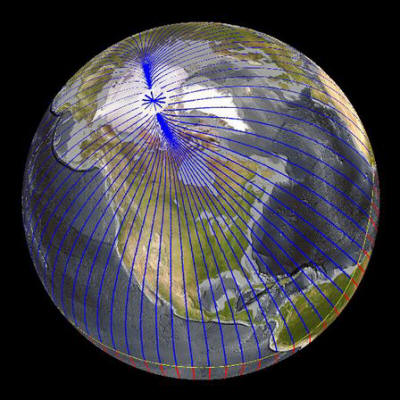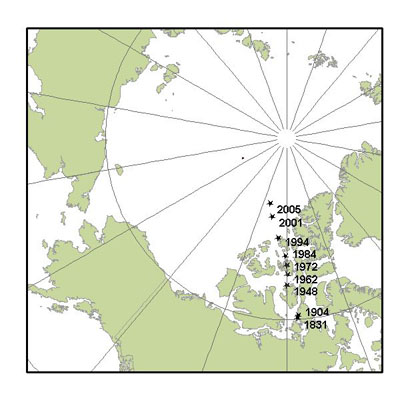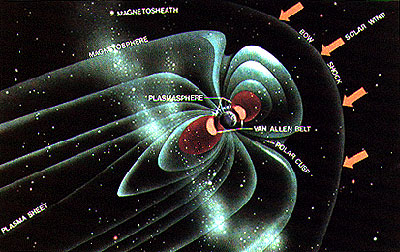|

2011
Spanish version
Shift of Earth's magnetic north pole affects Tampa airport
January 5, 2011
from
TampaBayOnLine Website

Runway changes are needed to account for the moving magnetic pole,
which is nearing Russia at 40 miles per year.
TAMPA
Scientists say the magnetic north pole is moving toward
Russia and the fallout has reached - of all places - Tampa
International Airport.
The airport has closed its primary runway until Jan. 13 to repaint
the numeric designators at each end and change taxiway signage to
account for the shift in location of the Earth's magnetic north
pole.
The closure of the west parallel runway will result in more activity
on the east parallel runway and more noise for residential areas of
South Tampa.
The busiest runway will be re-designated 19R/1L on aviation charts.
It's been 18R/36L, indicating its alignment along the 180-degree
approach from the north and the 360-degree approach from the south.
Later this month, the airport's east parallel runway and the seldom
used east-west runway will be closed to change signage to their new
designations.
The Federal Aviation Administration required the runway designation
change to account for what a National Geographic News report
described as a gradual shift of the Earth's magnetic pole at nearly
40 miles a year toward Russia because of magnetic changes in the
core of the planet.
North Magnetic Pole Moving Due to Core Flux
by Richard A. Lovett
in San Francisco
December 24, 2009
from
NationalGeographicNews Website

Blue lines show Earth's northern magnetic field and the magnetic
north pole in an artist's rendering.
Picture courtesy Stefan Maus, NOAA NGDC
Earth's north magnetic pole is
racing toward Russia at almost 40
miles (64 kilometers) a year due to magnetic changes in the planet's
core, new research says.
The core is too deep for scientists to directly detect its magnetic
field. But researchers can infer the field's movements by tracking
how Earth's magnetic field has been changing at the surface and in
space.
Now, newly analyzed data suggest that there's a region of rapidly
changing magnetism on the core's surface, possibly being created by
a mysterious "plume" of magnetism arising from deeper in the core.
And it's this region that could be pulling the magnetic pole away
from its long-time location in northern Canada, said Arnaud Chulliat,
a geophysicist at the Institut de Physique du Globe de Paris in
France.
Finding North
Magnetic north, which is the place where compass needles actually
point, is near but not exactly in the same place as the geographic
North Pole. Right now, magnetic north is close to Canada's Ellesmere
Island.
Navigators have used magnetic north for centuries to orient
themselves when they're far from recognizable landmarks.
Although global positioning systems have largely replaced such
traditional techniques, many people still find compasses useful for
getting around underwater and underground where GPS satellites can't
communicate.
The magnetic north pole had moved little from the time scientists
first located it in 1831. Then in 1904, the pole began shifting
northeastward at a steady pace of about 9 miles (15 kilometers) a
year.
In 1989 it sped up again, and in 2007 scientists confirmed that the
pole is now galloping toward Siberia at 34 to 37 miles (55 to 60
kilometers) a year.
A rapidly shifting magnetic pole means that magnetic-field maps need
to be updated more often to allow compass users to make the crucial
adjustment from magnetic north to true North.
Wandering Pole
Geologists think Earth has a magnetic field because the core is made
up of a solid iron center surrounded by rapidly spinning liquid
metal. This creates a "dynamo" that drives our magnetic field.
(Get more
facts about Earth's insides.)
Scientists had long suspected that, since the molten core is
constantly moving, changes in its magnetism might be affecting the
surface location of magnetic north.
Although the new research seems to back up this idea, Chulliat is
not ready to say whether magnetic north will eventually cross into
Russia.
"It's too difficult to forecast," Chulliat said.
Also, nobody knows when another change in the core might pop up
elsewhere, sending magnetic north wandering in a new direction.
Chulliat presented his work this week at a meeting of the
American Geophysical Union in San Francisco.
Why does the North Pole move?
by Tracy V. Wilson
from
ScienceHowStuffWorks Website
The Earth has several poles, not just two. It has geographic north
and south poles, which are the points that mark the Earth's axis of
rotation.
It also has magnetic north and south poles, based on the
planet's magnetic field. When you use a compass, it points to the
magnetic north pole, not the geographic North Pole.

Image courtesy Kenai National Wildlife
The Earth's magnetic poles move. The magnetic North Pole moves in
loops of up to 50 miles (80 km) per day.
But its actual location, an
average of all these loops, is also moving at around 25 miles a year
[ref]. In the last 150 years, the pole has wandered a total of about
685 miles (1102 kilometers).
The magnetic South Pole moves in a
similar fashion.

Image courtesy NASA
Earth's magnetic field protects it from the solar wind.
The poles can also switch places. Scientists can study when this has
happened by examining rocks on the ocean floor that retain traces of
the field, similar to a recording on a magnetic tape.
The last time
the poles switched was 780,000 years ago, and it's happened about
400 times in 330 million years. Each reversal takes a thousand years
or so to complete, and it takes longer for the shift to take effect
at the equator than at the poles. The field has weakened about 10%
in the last 150 years. Some scientists think this is a sign of a
flip in progress.
The Earth's physical structure is behind all this magnetic shifting.
The planet's inner core is made of solid iron. Surrounding the inner
core is a molten outer core. The next layer out, the mantle, is
solid but malleable, like plastic.
Finally, the layer we see every
day is called the crust.

Image courtesy USGS
The Earth's layers include the inner core, outer core, mantle and
crust.
Aurora
The magnetic North Pole is responsible for more than just the
direction a compass points. It's also the source of the aurora
borealis, the dramatic lights that appear when solar radiation
bounces off the Earth's magnetic field.
This happens at the South
Pole as well. In the southern hemisphere, the lights are called the
aurora australis.
The Earth itself spins on its axis. The inner core spins as well,
and it spins at a different rate than the outer core. This creates a
dynamo effect, or convections and currents within the core. This is
what creates the Earth's magnetic field - it's like a
giant
electromagnet.
Exactly how the dynamo effect changes the field isn't widely
understood.
Shifts in the core's rate of spin and the currents
within the molten material most likely affect the planet's field and
the location of the poles. In other words, the poles move because
the convection in the core changes. These changes might also cause
the poles to switch places.
Irregularities where the core and mantle
meet and changes to the Earth's crust, like large earthquakes, can
also change the magnetic field.
VIDEOS
|





